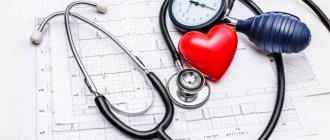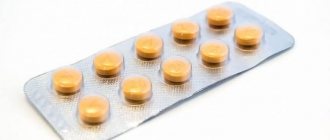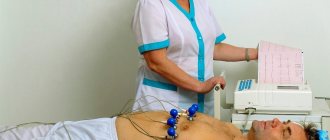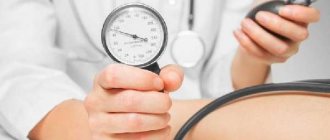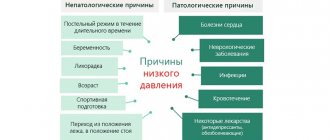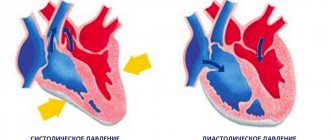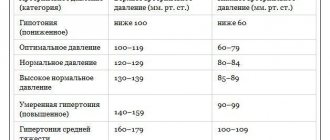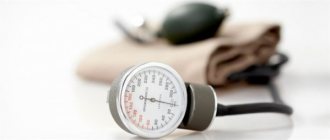What does pressure 140 to 80 mmHg mean? Art.?
Oxygen and nutrients enter our body through blood, which circulates through the vessels, exerting a certain pressure on them. Blood pressure manifests itself as a result of the process of compression of the walls of blood vessels. The unit in which it is measured is millimeters of mercury.
There are upper (systolic) and lower (diastolic) blood pressure. The indicator of upper blood pressure depends on the force and speed of the heart pushing blood into the vascular system. Lower - minimum pressure during the pause between compressions.
Blood pressure indicators depend on factors such as:
- the volume of blood that circulates in our body;
- vascular resistance to blood flow;
- an indicator of the strength of heart contractions.
Blood pressure can depend on both a person’s gender and age. However, the norm for most people is 120/80. Although each person’s blood pressure may be individual, deviations from this indicator are considered a cause for concern.
If your blood pressure is 140 over 80, what does that mean? A reading of 140 indicates that the upper systolic blood pressure is elevated. In the case when the upper pressure is 140 and the lower 80 is normal, the initial development of arterial hypertension is possible.
What to do if your blood pressure is 140 over 80 and your pulse is 80? First, let's decide on the question of what heart rate is considered normal for a person.
Normal heart rate for:
- teenagers - 55–95;
- people under 50 years old - 60–80;
- elderly people over 50 years old - 70–90.
Thus, we see that the pulse rate is not exceeded and it is necessary to treat the manifestations of hypertension directly. Based on this, in the case when the pressure is 140 to 80, while the pulse is 80 beats per minute, there is no serious cause for concern, except for directly increased blood pressure.
Blood pressure 140 over 85 is this normal? An increase in lower blood pressure can normally range from 60 to 85 mm Hg. Art. If your reading is 85 occasionally during the day, there is no cause for concern. But in case of chronic manifestation of the maximum indicator of lower blood pressure, especially in combination with increased systolic blood pressure, it is necessary to consult a doctor.
Is it normal?
It is impossible to say that 140 over 80 is normal pressure. Because even this, albeit not a very significant increase in blood pressure, is a sign of the manifestation of stage 1 hypertension.
With such pressure, many people do not notice a deterioration in their health or the appearance of any signs of illness. However, despite this, if you do not see a doctor and do not start treating the developing disease in time, it can progress and seriously affect the internal organs of a person.
The main symptoms of hypertension are:
- heartache;
- dizziness;
- nausea;
- pain in the back of the head;
- pulsation in the veins;
- clouding of consciousness;
- fear and feeling of anxiety.
In men
According to statistics, men are more susceptible to cardiovascular diseases than women. Risk factors for the stronger half of humanity are: heredity, smoking, age, obesity. The causes of hypertension in men are:
- heavy physical exertion on the body;
- poor nutrition;
- uncontrolled use of drugs;
- frequent use of alcohol and tobacco;
- a permissive attitude towards your body.
What to do with a blood pressure of 140 to 80 in men? Treatment and prevention of various indicators of high blood pressure, including 140/80 in men, is as follows:
- reducing salt intake;
- marinades, spices, spicy;
- reducing alcohol consumption;
- quitting tobacco;
- reducing physical activity;
- reducing stress levels.
In a teenager
The modern rhythm of life and the state of the environment are such that many diseases that were previously characteristic of older people are beginning to appear among young people. Blood pressure norms for adolescents are approximately the same as for adults: 100–140 per 70–90 mmHg. Art., pulse 60–80 beats.
The reasons for pressure 140 to 80 in a teenager can be:
- excessive physical activity;
- hormonal changes;
- poor nutrition;
- obesity;
- stress and emotional stress;
- heredity.
During pregnancy
Pressure of 140 over 80 during pregnancy can be caused by the fact that when women carry a fetus, the amount of circulating blood increases. In this case, the vessels can hardly bear such loads, and internal discomfort occurs.
Features of treatment for pregnant women include the need to constantly be under medical supervision to avoid a decrease in heart rate. Such patients are limited in the use of medications. You should not take alcohol tinctures so as not to harm the fetus. Doctors usually advise pregnant patients to:
- eat the fruits of viburnum and lingonberries;
- drink teas with lemon balm and mint.
However, this recommendation will be useful to all people who detect a pressure of 140 to 80 on a tonometer. What are the reasons and what to do in this case?
The first symptoms of hypertension
At a pressure of 135 to 85 or 128 to 90 mmHg. Art. A person may experience no unpleasant symptoms at all. But with nervous or physical stress, the manifestations become obvious. This:
Blood pressure 150 over 100
- headache (headache in the back of the head or in the temporal region);
- nosebleeds;
- increased heart rate;
- flashing black dots before the eyes;
- tinnitus;
- painful sensations in the chest;
- sleep disturbance.
Such symptoms are transitory. During remission, the person feels normal and does not notice any problems with well-being. This is the main insidiousness of the disease. Over time, the pressure of 135 to 95 becomes constant, increasing during attacks to critical values.
Important! The situation is also dangerous when diastolic pressure drops below acceptable values and the pulse difference increases. Blood pressure 130 at 65 mm Hg. Art. Such values are a symptom of a malfunction of the excretory system, which can lead to a stroke. But for professional athletes who daily subject their bodies to increased stress, such pressure is normal.
Causes
The causes of pressure 140 to 80 can be:
- heredity;
- abuse of fatty, salty, spicy foods;
- nervous exhaustion;
- passive lifestyle;
- presence of unhealthy habits such as smoking, drinking alcohol;
- strong physical activity;
- stress.
Risk factors for high blood pressure
Consequences of secondary hypertension
Even if a blood pressure of 135 over 90 or 138 over 90 does not affect your well-being, it can gradually worsen the blood supply to tissues and cells. As a result, a cerebral stroke, sclerotic changes in the kidneys, hypertrophy of the left cardiac ventricle, and microinfarction may develop. And even though, according to statistics, this probability is only 15%, it is not worth risking your own health.
The pressure should be reduced if the increase in values causes a deterioration in health and does not return to normal within a few days. The use of potent drugs prescribed to chronic hypertensive patients is not recommended.
What to do?
In total, there are three degrees of hypertension, and an indicator of 140 to 80 indicates the first degree. If the pressure is 140 over 80, what should I do?
You should only worry if it persists continuously for a long time. And by immediately contacting a doctor, you can prevent the disease from developing. If such indicators are not frequent, then there is no reason to worry, and you can get by with general independent measures to improve your health.
Don't rush to take medications, you can try first:
- to refuse from bad habits;
- start going for a massage;
- eliminate junk food;
- engage in light physical activity;
- give up coffee;
- go on a diet.
Doctors also recommend:
- drink medicinal herbs;
- drink cocktails containing oxygen;
- take hydrogen sulfide baths;
- sauna.
Causes of isolated systolic hypertension
This disease indicates that adverse changes are occurring in the cardiovascular system that require the intervention of specialists. Timely treatment will help avoid complications.
Most often, hypertension is a short-term phenomenon, to eliminate which you just need to give up physical activity, review your diet, and give up coffee and other energy drinks.
Many people are at risk due to a sedentary lifestyle, hard work and poor diet. All these factors negatively affect health, and make themselves felt in old age.
Treatment of the disorder
At the first stage of hypertension, normal blood pressure can be returned with the help of modern medications that reduce low blood pressure, for example, diuretics. Alternative techniques are also used - acupuncture, massage of biologically active points, therapeutic baths, electrophoresis and other techniques.
The treatment regimen for arterial hypertension also includes a diet that limits the consumption of salt, fatty and high-calorie foods. Animal fats are replaced with vegetable fats, baked goods and sweets with dried fruits, sugar with honey, fatty pork with lean poultry and fish.
Medicinal plants such as rosehip, an infusion of which can successfully replace your usual morning coffee, will help correct blood pressure.
What cannot be done at the early stage of diastolic hypertension? The list of absolute contraindications includes:
- smoking;
- alcohol abuse;
- lack of physical activity;
- stress;
- lack of sleep;
- binge eating;
- excessive physical and nervous overload.
Important! Even if there are no symptoms and you feel well with a blood pressure of 133 over 88 or 137 over 90, you should not refuse regular blood pressure monitoring at home and visits to your doctor. Monitoring the potential development of hypertension allows timely recognition of deviations from the norm and taking measures to correct the condition.
Diagnostic measures
If there is a periodic increase in blood pressure, it is recommended to purchase a home tonometer, which allows you to quickly and extremely accurately measure blood pressure without medical assistance. Automatic and semi-automatic devices are best suited for these purposes, the use of which does not require special medical skills.
It is important to follow some rules on which the reliability of the results reflected on the monitor depends:
- 30–60 minutes before the start of the diagnostic procedure, you should not smoke, eat salty or fatty foods, drink alcohol or drink coffee;
- the person should be as relaxed and calm as possible; you cannot move or talk during the procedure;
- the best position is sitting on a comfortable chair, leaning your back on the back and placing your hand on the table;
- pressure is measured first on one arm, after 10 minutes - on the second;
- Blood pressure should be monitored twice a day - in the morning and in the evening, unless the doctor determines another monitoring time;
- the obtained data is entered into the pressure monitoring log.
When the values are 130–137 at 90 mmHg. Art. become permanent, the person is sent for examination, which includes the following activities:
- blood pressure measurement according to a schedule determined by a specialist at home and daily monitoring in a hospital setting;
- an electrocardiogram to assess the stability of the heart;
- blood test for the concentration of potassium and hormones in the blood;
- urine test to check the condition of the kidneys and excretory system;
- Ultrasound of the kidneys and heart;
- renal arteriogram, radiography.
